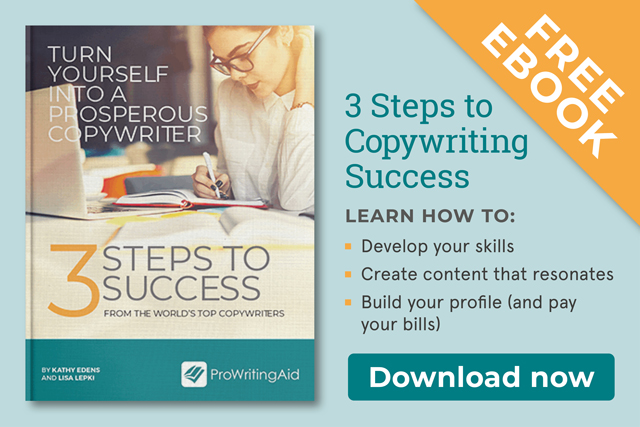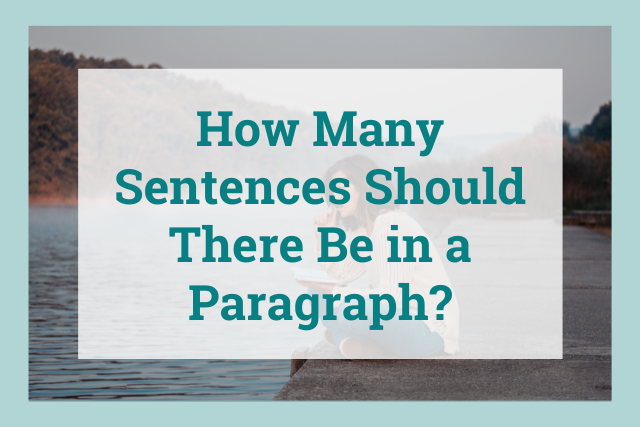
There are a lot of writing rules out there, and they can be restricting, especially when they start to feel a little formulaic. If you’ve ever been told that a paragraph should always be at least three sentences long, but ideally five to seven, then you know what I mean.
Why does it have to be so specific?
The truth is that these rules are meant to be guidelines to make writing easier for you. If they start to do the opposite, though, they defeat the purpose.
How Long Should a Paragraph Be?
So here is what you really need to know: There is no general rule for how long your paragraphs should be. In fact, you probably want to vary your lengths in order to make your writing feel less like a robot wrote it and more human-friendly. A good paragraph isn’t one that has a set amount of sentences. It’s one that has a good, focused idea.
So, in this post, I’m going to talk about what makes a good paragraph, regardless of length. However, despite what I just said, sometimes you just have to follow the formula, so I’ll also point out some best practices on paragraph length. While I am going to focus on academic papers, I’ll also talk about good paragraphs in web writing, professional writing, and fiction.
What Do Teachers Want to See in a Paragraph?
Before you start thinking about length, you should first start thinking about what makes a good paragraph. Throughout this section, I’ll be using a lot of food analogies, so you should probably grab a snack whilst you read.
A good paragraph is like a bite of a sandwich. If you bite off too much, then you might choke. However, if you just take a tiny little nibble, you will barely taste it at all. In the same way, if your paragraph has too much information in it, then it is just going to be confusing and hard to swallow (get it?). However, if there is only one sentence, then there won’t be enough meat to let your reader know what your point is. So, you have to find the balance between those two things.
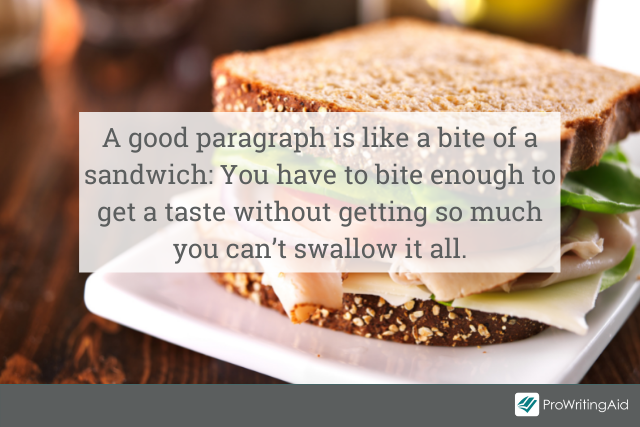
There are many acronyms that help determine paragraph structure. In school, you might have learned something like ICE for body paragraphs, which stands for introduce, cite, and explain evidence. However, to fit my sandwich theme, I use MEAL or MEAT.
A good body paragraph in an academic paper should do one of these:
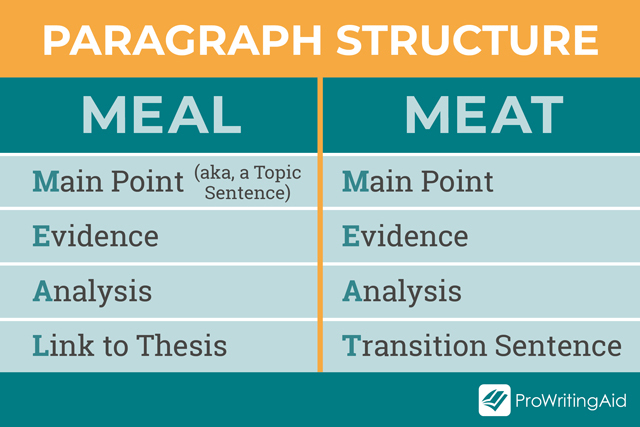
MEAL: Main Point, Evidence, Analysis, Link to Thesis
MEAT: Main Point, Evidence, Analysis, Transition Sentence
Only the last letters of these are different, so let’s talk a bit about what each acronym means.
How Do I Structure a Paragraph?
Main Point
A good paragraph should have a main point or topic sentence. This is kind of like a mini-thesis statement for your paragraph or the paragraph’s controlling idea. You should have a single controlling idea in your paragraph.
A good way to test this is to do what is called a reverse outline: Summarize each of your paragraphs into one simple topic sentence. (Don’t combine two sentences with a conjunction. That’s cheating!)
If you cannot get a complete sentence to sum up your paragraph, then it is too short. If you can’t fit the point into one sentence, then you likely have two main ideas, which should be broken into multiple paragraphs.
Evidence
After you get the topic sentence of the paragraph, you need some supporting sentences to help you prove your claim. This is where your outside sources come into the picture. You can put in a sentence or two explaining how you know your main sentence is true.
Analysis
Don’t just put evidence up without explaining how it proves your point. Somebody might read the same quote, data, or theory as you and come to a completely different conclusion about what it means. So once you add in some evidence, take another two or three sentences and explain how that evidence proves your point.
Link to Thesis/Transition Sentence
Once you’ve finished the information in your paragraph, you can’t just move on. You need a good ending to your paragraph. This is where you have a few options. In your concluding sentence, you might want to show how the main point you are making in that section of the paper helps prove your thesis statement. This fits your paragraph into the premise of your writing.
Alternatively, you might want to focus on getting into your next main point. You can do this by creating a transition sentence that will bridge the gap between the previous paragraph and the one that follows it, creating a logical progression.
A Special Note on Introduction/Conclusion Paragraphs
Think of an academic paper as a funnel. When you first start writing, your audience has no idea what you are discussing, so they need you to draw them in first. Then, once you get into the body, you should be narrow and focused on your topic. Finally, at the end, you should send your reader back out to the rest of the world with a better understanding of your topic and what they should do about it.
Because the body paragraphs are narrower, the MEAL/MEAT plan works best for these. However, introductions and conclusions are a little different. Let’s discuss.
How Long Should an Introduction Paragraph Be?
Again, there's no right or wrong answer here. It's all about the content.
Just like body paragraphs, there is a good acronym to help you remember what goes into an introduction paragraph, though this one isn’t food-centric: ABC.
A: Attention grabber, also known as a hook. You want to get your readers interested in your topic and let them know why they want to keep reading.
B: Background information. This is where you will give the reader enough information to catch them up on the topic. Let them know what they need to know to understand and follow your paper.
C: Claim, or the thesis statement. What is the main argument your paper will be making? What are you trying to prove or say? This should be really clear and straightforward.
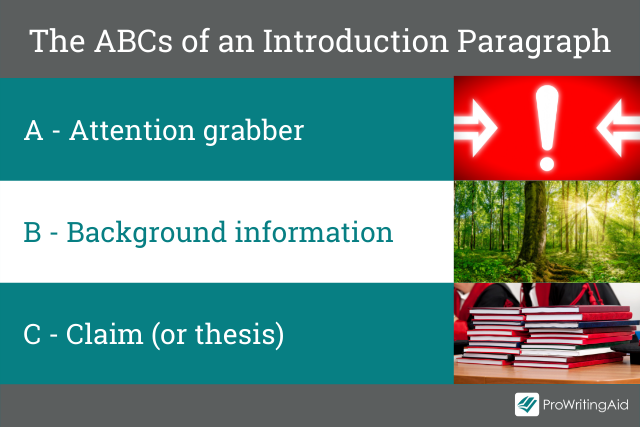
What Do You Include in a Conclusion Paragraph?
If you start with ABC, then it makes sense that you should end with XYZ. Notice that these are different letters. You don’t want to just repeat the introduction.
X: Explain what they should do with all of this information once they are done. This is sometimes called a "Call to Action". Likely, you want them to go away from academic writing being convinced about your thesis statement.
Y: Let them know why (y) they should care about all the information they just read.
Z: Zap them with a final hook in the concluding sentence so they don’t forget what you just taught them.
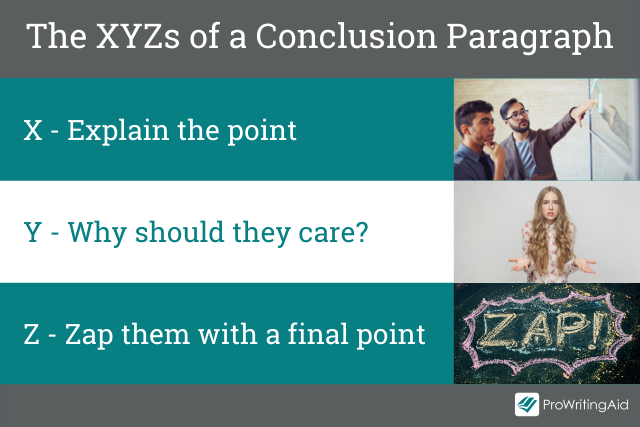
OK. But Really, How Many Sentences Should an Academic Paragraph Have?
I know I just spent a lot of time telling you that the content matters more than the amount of sentences in a paragraph, and I stand by that. However, I also acknowledge that there are best practices when it comes to paragraph length, and it helps to know them.
So, on average, there will be about 3 to 7 sentences in a paragraph. This is how many it takes to convey all of the necessary information I mentioned above into a paragraph without putting in too much.
You could also think of it as about half a page long, though that depends on how many words are in your sentences. More than that, and it will be harder to follow. Shorter than that, and it won’t feel like it has enough depth (and if you have a page-length requirement, it’ll be harder to hit it).
TIP: When I am teaching, I find that people who tend to turn in papers that are too short also have really short paragraphs. It’s usually because they don’t have enough sentences in their analysis section. So if you have this problem, then you might want to make sure you have enough of your own explanations about why the evidence you use supports your claims.
Can a Paragraph Be One Sentence?
That depends on where you’re writing.
I spent a lot of time talking about a good paragraph in academic writing because that tends to be more formulaic than other types of writing. However, the answer to what makes a good paragraph (and how many sentences that paragraph should have) really depends on the type of writing you are doing. So here is where I will talk more about some other common types of writing that you may do.
How Long Are Paragraphs in Web/News Articles?
In web articles and news stories, can a good paragraph ever be a single sentence long?
Yes.
One-sentence paragraphs are great for web writing. When people are online, they skim more. Thus, it is always smart to break up paragraphs more than you would in a paper.
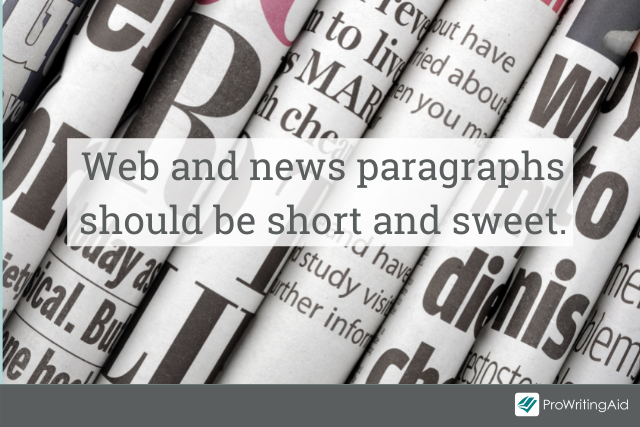
On the web, short paragraphs are good. However, each paragraph still needs to have good information in it. If your readers can skim your writing and still get the important information you want to relay to them, then you are doing a good job.
This is also true in journalism. You likely want to keep your paragraphs tight and to the point. You don’t need a lot of sentences to give readers the facts.
Should I Use Short Paragraphs in Emails?
The answer to how long a good paragraph in a professional writing task should be is going to vary widely based on the task and industry. Your best bet is to find some good samples that will help you see what is expected of you.
However, let’s talk a little bit about a professional writing task almost everyone will have at some point: the email.
A good email paragraph in a professional context is one that gives the reader enough information to understand the problem and to figure out the question being asked. That question should be directly stated so that it is more likely to get answered.
In other words, it should be exactly how long it needs to be and no longer. People are busy, they don’t have time for a five-page email!
Here are the basic components of most business emails:
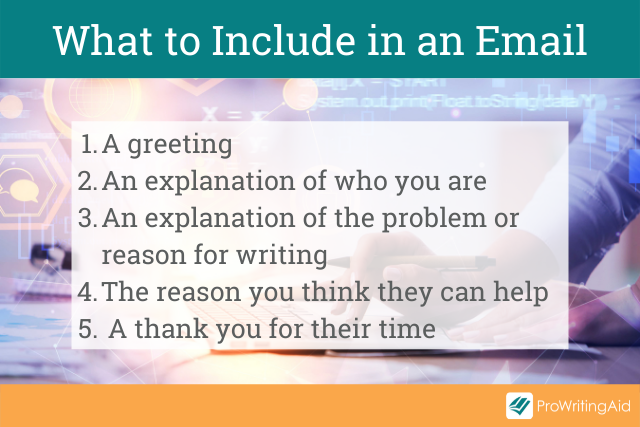
- A greeting
- An explanation of who you are.
- An explanation of the problem or reason for writing.
- The reason you think they can help.
- A thank you for their time.
This is really all that is needed in the paragraph(s) of an email.
How Long Should a Fiction Paragraph Be?
To be honest with you, this is going to be the hardest part of this whole post to write. The reason for this is because creative writing is like the Wild West: There are no rules, and you might get into a showdown if you try to suggest any.
Seriously, creative writing is just that, creative. Well-known books have paragraphs as short as one word and as long as the entire novel! A big part of what makes a good paragraph in creative writing is personal style. In other words, BE YOU.

Still, though, if you want to get published and develop an audience, you might have to stick to some best practices sometimes. Try starting a new paragraph if you do any of the following:
Create any type of change
Introduce a new character or place
Add dialogue
While that isn’t a complete list, it is a good starting point.
Of course, if you are still worried about the length of your paragraphs, you can always let ProWritingAid help. For example, check out the Readability Report, which will help you figure out which paragraphs are hard to read.
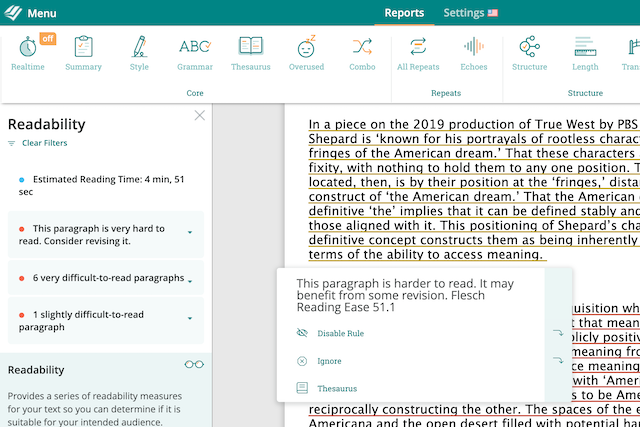
If it’s very difficult, it might mean there is too much information in there. Try breaking it down and running the report again to see if it improves your score.
Test your writing’s readability now with a free ProWritingAid account.

